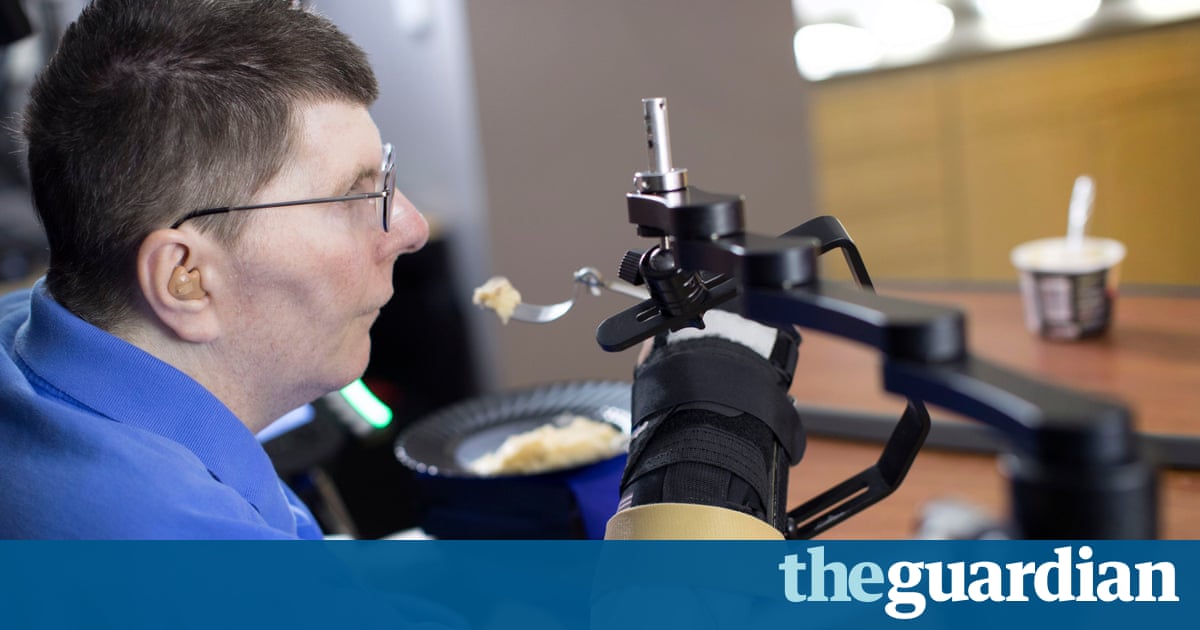 A man who was paralysed from below the neck after crashing his bike into a truck can once again drink a cup of coffee and eat mashed potato with a fork, after a world-first procedure to allow him to control his hand with the power of thought.
A man who was paralysed from below the neck after crashing his bike into a truck can once again drink a cup of coffee and eat mashed potato with a fork, after a world-first procedure to allow him to control his hand with the power of thought.
Bill Kochevar, 53, has had electrical implants in the motor cortex of his brain and sensors inserted in his forearm, which allow the muscles of his arm and hand to be stimulated in response to signals from his brain, decoded by computer. After eight years, he is able to drink and feed himself without assistance.
“I think about what I want to do and the system does it for me,” Kochevar told the Guardian. “It’s not a lot of thinking about it. When I want to do something, my brain does what it does.”
The experimental technology, pioneered by the Case Western Reserve University in Cleveland, Ohio, is the first in the world to restore brain-controlled reaching and grasping in a person with complete paralysis.
For now, the process is relatively slow, but the scientists behind the breakthrough say this is proof of concept and that they hope to streamline the technology until it becomes a routine treatment for people with paralysis. In the future, they say, it will also be wireless and the electrical arrays and sensors will all be implanted under the skin and invisible.
“Our research is at an early stage, but we believe that this neuroprosthesis could offer individuals with paralysis the possibility of regaining arm and hand functions to perform day-to-day activities, offering them greater independence,” said Dr Bolu Ajiboye, lead author of a paper detailing the research in the Lancet medical journal.
“So far it has helped a man with tetraplegia to reach and grasp, meaning he could feed himself and drink. With further development, we believe the technology could give more accurate control, allowing a wider range of actions, which could begin to transform the lives of people living with paralysis.”
Functional electrical stimulation (FES) of the muscles and nerves has been tried before in patients with paralysis, but they have had to use whatever movements they have left, such as shoulder shrugs or head nods, to trigger it. Kochevar, however, only has to think about what he wants to do.
He underwent brain surgery to implant sensors in the motor cortex area responsible for hand movement, linked to a computer. Kochevar went through four months of training, thinking about the turn of the wrist or grip of the fingers that he needed in order to bring about the movement of a virtual reality arm, so that the computer could recognise the necessary signals from the motor cortex.
Then he had 36 muscle-stimulating electrodes implanted into his upper and lower arm, including four that helped restore finger and thumb, wrist, elbow and shoulder movements. These were switched on 17 days after the procedure, and began stimulating the muscles for eight hours a week over 18 weeks to improve strength, movement and reduce muscle fatigue.
Then the whole system was connected up, so that signals from the brain were translated via a decoder into electrical impulses to trigger movement in the muscles and nerves in his arm.
“It was wow – I can do that now!” he said. “In the future I will be able any time I want to take a drink of something or feed myself.”Kochevar lost all power of movement after an accident during a charity bike ride in Cleveland for the MS Society. He was riding behind a mail truck, he said, when it stopped suddenly. “I went head first into it,” he said.
Ajiboye said he wanted Kochevar to be able to move his arm easily. “That is the goal – to make the technology seamless to him, in the sense of he thinks about him moving his arm and it moves,” he said.
The limitation for now was the number of muscles that could be stimulated and the wires that extrude. The slowness of the movement was not something that bothered patients, he said. “If you ask the users what their primary goal is, it is function not speed.”
There is no question of curing paralysis through this technology – it circumvents the injury instead.
“The goal is futuristic: a paralysed individual thinks about moving her arm as if her brain and muscles were not disconnected, and implanted technology seamlessly executes the desired movement … this study is groundbreaking as the first report of a person executing functional, multi-joint movements of a paralysed limb with a motor neuroprosthesis,” said Dr Steve Perlmutter from the University of Washington, in a linked comment in the Lancet.
“However, this treatment is not nearly ready for use outside the lab. The movements were rough and slow and required continuous visual feedback, as is the case for most available brain–machine interfaces, and had restricted range due to the use of a motorised device to assist shoulder movements … Thus, the study is a proof-of-principle demonstration of what is possible, rather than a fundamental advance in neuroprosthetic concepts or technology. But it is an exciting demonstration nonetheless,








